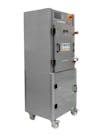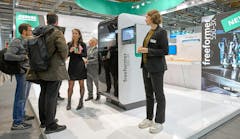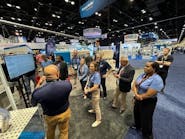
Hozumi Yoda, president of injection molding machinery maker Nissei Plastic Industrial Co. Ltd., Nagano, Japan, continues the company's tradition of innovation through invention with the opening this year of the company's first North American production facility.
Creating manufacturing plants outside of Japan is a recent part of the company's strategy, under Yoda's direction, to establish a global system that places production closer to local markets, with the goal of shorter delivery times. Nissei established a factory in China in 2009 and set up a factory in Thailand in 2012. It also has invested $21 million in Nissei Plastic Machinery America Inc., a new 115,000-square-foot building in San Antonio.
Yoda said Nissei's success as an injection molding machine supplier today is based on utilizing the strengths accumulated in the past while anticipating markets and business positions the company can engage in. The influences in his personal and business life include his grandfather, Katashi Aoki, who founded the company in 1947 and served as its first chairman. Aoki has passed down his passion for plastic — evidenced by the 932 inventions patented under his name — to his grandson. In 2011, Nissei's founder was inducted into the Plastics Hall of Fame.
Nissei celebrated its 70th anniversary last year. This month marks 40 years since the company established Nissei America Inc., its U.S. sales and service office in Anaheim, Calif.
With the assistance of translators provided by Nissei, Yoda recently discussed his career with Plastics Machinery Magazine senior staff reporter Mikell Knights.
Tell me about your grandfather.
Yoda: My grandfather's inventions are related to plastic products, plastic processing methods, structures and mechanisms of injection machines and blow molding machines, etc. He invented a rotary-ram-type inline-screw injection mechanism, a low-noise hydraulic molding machine, a mold-clamping mechanism for Nissei's FS type-hydraulic molding machine. He invented a design that concentrates the piping for an injection molding machine, and he developed a biaxial stretch blow molding machine.
What is your educational and professional background?
Yoda: I graduated from Tokai University, College of Liberal Arts, then joined Nissei in 1989 where I was responsible for the planning, projecting and participation of the company at plastics machinery shows. At that time, I studied matters relating to machinery, machining, marketing and project participation. I spent much time during my childhood with my grandfather and plastics machinery being built by the family company. My playground was a factory of Nissei Plastic.
I have been a part of several business industry associations. This includes a current position as chairman of the Association of Japan Plastics Machinery, the only association of the major plastics and rubber processing machinery manufacturers from Japan. I am also a supporting member of the Japan Society of Polymer Processing, and, in March 2003, was an administration officer for the International Plastic Fair Association in Japan.
What company machinery developments do you think have had the most impact on the industry?
Yoda: Nissei had led the industry as a technology developing company, especially with the development of the rotary inline raw-screw injection mechanism in 1961. Nissei developed the first electric injection molding machines in the world, in 1983. Nissei's double-color machines are the de facto standard. And Nissei is a leader in the market in making hybrid injection molding machines, with the development of its X-Pump system.
Have you developed any new technologies or processes?
Yoda: I have received a patent for X-Pump, a drive-train system that uses a variable-speed electric servomotor to drive a hydraulic oil pump. The system uses 55 percent less oil and 40 percent less energy than a system operating a hydraulic pump and valve. I also have a patent on N-Sapli, a low-clamp pressure molding method that allows for larger high-quality parts to be molded on a smaller press. N-Sapli was developed for covering what all-electric-type machines were not good at: long-time pressuring, ultra-low-speed injection control, acceleration and high-torque delivery. And it takes advantage of direct-clamping approaches. I also have a patent related to a large machine clamping mechanism. The flat clamp improves the uniform distribution of clamping pressure applied to the platen. I have a patent on a method of monitoring the state of plasticization of the molten resin by acoustic emission.
What additional plastics-related developments is Nissei engaged in?
Yoda: In 2007, Nissei developed the Voltiga high-functional carbon nanotube/resin composite material, developed to be used to dispense a carbon nanotube material into a resin for improved properties. We are developing an Internet of Things [IoT] technology that will be compatible with Euromap 77 and Euromap 83 protocols for communication between machinery and other equipment or devices. The IoT system under development operates on molding machines equipped with our newest Tact 5 machine controller that incorporates the OPC-UA industrial communications protocol. OPC-UA provides a common data platform for machinery, equipment, computers and personnel to interact and to optimize the molding cycle and molding conditions by using monitored data and information from connected peripheral devices. It also predicts the life of the part by information gathered from various sensors mounted in the molding machine.
What do you think the next generation of injection molding machines will look like/do?
Yoda: Plastic products will be made by 100 percent green plastics materials such as biomass or PLA [polylactic acid] from non-petroleum-origin materials. Consequently, the specialized injection molding machine for making green products will be cutting-edge technology. The specification of a clamping force will be de-emphasized, and the importance of controlling the remaining air inside of the mold will receive more attention. The size of the injection molding machine will get smaller, while the time, energy consumption and use of the machine will be dramatically more versatile.
What role will Nissei's new U.S. manufacturing facility play in the company's overall goals?
Yoda: The facility will initially be used for machining and assembly of medium- to large-scale hybrid injection molding machines with clamping forces from 560 to 1,440 tons; however, the facility is equipped to produce machines with up to 3,300 tons of clamping force.
The main machinery components will gradually be sourced from local suppliers and branded as "Made in USA." Manufacturing locally brings lower transportation costs and faster delivery and shorter response times when machine modifications are required, when compared to orders shipped here from Japan.
We believe there is a competitive market for competitively priced injection molding machines made locally. The San Antonio plant will supply markets throughout the Americas, including South and Central America and the United States and Canada. It may, in the future, supply European markets, as well.
Nissei expects to produce 29 machines at the new U.S. plant in its first full year of operation. The San Antonio facility will also house a technical center.
What would you like to be remembered for, although it is early in your career?
Yoda: I have realized — through good decision-making and achieving overseas production — the globalization of the company, which is significant. In terms of machinery, recognizing that hybrid and electric molding machines are the two pillars of the company and the route for growth and evolution of the company.







